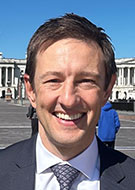RSNA Advocacy Efforts Seek to Advance Radiology and Support for Medical Imaging Research
The Society advanced its government relations initiatives through targeted events and issue-based engagement with the federal government


RSNA continues to expand its government relations efforts to advocate for policies that support radiologists, protect access to imaging, and advance medical research. By engaging with policymakers, the RSNA Government Relations Committee works to ensure that the value of radiology in patient care and innovation is clearly understood and effectively represented.
“Our role is to ensure that the voice of radiologists is heard where decisions are made,” said Pari V. Pandharipande, MD, MPH, RSNA Board liaison for government relations and chair of radiology at Penn Medicine. “We advocate for research funding, policies that support the responsible advancement of imaging technology, and protections that ensure patients continue to have access to the diagnostic tools and expertise they need.”
The RSNA Board of Directors established the Society’s government relations initiative in 2022. Current efforts focus on elevating the expertise of radiologists to inform pressing challenges in medical research and patient care across three key areas: the use of AI in medicine and imaging; theranostics and precision medicine; and federal investment in biomedical and health research.
RSNA Participates in Virtual Town Hall
Libby O’Hare, PhD, director of Government Relations at RSNA, recently served on an expert panel in a virtual Town Hall hosted by the Academy for Radiology & Biomedical Imaging Research (Academy).
Dr. O’Hare was joined in the discussion by Lynn Marquis, Academy senior director for government relations and strategic initiatives, Renee L. Cruea, executive director of the Academy, and Katie Grady, government affairs director, American College of Radiology (ACR). The conversation focused on the fiscal year (FY) 2026 federal budget and appropriations process and its impact on imaging and radiology research.
Dr. O’Hare discussed what the imaging community could expect through the remainder of FY 2025, which ends on Sept. 30. She provided an overview of the current dynamic at the NIH, including the dramatic slowdown of the agency’s grantmaking capacity in recent months due to a variety of policy changes and direct and indirect actions taken to reduce federal spending.
Some of these Trump Administration actions include new Terms & Conditions of awards; additional post approval reviews for grants deemed worthy of funding by peer review and Institute Advisory Councils; and the fact that the agency hasn’t published new program funding opportunities since January. Coupled with numerous terminated grants and institution-specific funding freezes, independent analyses demonstrate that the NIH has awarded at least $3.5 billion less funding compared to this time last year[1].
Looking ahead to FY 2026, President Trump’s budget request proposes to cut the NIH’s funding by $18.1 billion, and would provide the agency with $27.9 billion, a funding level not seen at the world’s leading funding of biomedical research since 2003.
Action now turns to the congressional appropriations committees who will be drafting their FY 2026 funding bills over the next several months. In this context, the Academy Town Hall panelists discussed the strategic positions of key players on the House and on the Senate Appropriations Committees and the many questions surrounding what the Administration’s budget proposal means for the scientific enterprise – specifically, NIH funding and research. Along with our partners in the medical research funding community, RSNA has taken several actions in support of NIH funding and policy.

RSNA members (left to right), Andrew Smith, MD, St. Jude's Children Hospital; Alex Towbin, MD, Cincinnati Children's Hospital; and Pari Pandharipande, MD, MPH.
Earlier Government Relations Activities This Year
In early March, RSNA joined over 600 biomedical and health research stakeholder organizations in urging congressional leadership to provide robust funding for the NIH and to preserve protections against harmful research policy changes.
Also in March, RSNA partnered with the Academy, co-sponsoring the 2025 Research Roundtable at the National Press Club in Washington, D.C. The Research Roundtable is a forum for key imaging, radiology industry and federal agency stakeholders to identify research gaps, establish priorities and explore opportunities for cross-sector collaboration.
“A critically important part of the experience was connecting with exceptional colleagues, ranging from those at the beginning of their careers to those who are very experienced, and hearing their thoughtful perspectives about topics critical to our field’s future,” Dr. Pandharipande said.
The day prior to the Roundtable, Dr. Pandharipande and other participants met with congressional offices on Capitol Hill, as part of the Academy’s 2025 Capitol Hill Advocacy Day.
“It was a privilege to represent the imaging research community and advocate for continued investment in radiology and biomedical imaging through funding of the NIH, NIBIB, and ARPA-H,” said Alex Towbin, MD, associate chief medical information officer at Cincinnati Children’s Hospital and vice-chair of RSNA’s Government Relations Committee. “Our visit was successful in amplifying the message that imaging research plays a pivotal role in driving innovation, improving patient care, reducing overall health care costs, and in powering the economy.”
The Capitol Hill meetings highlighted the connection between research and human health and gave the attendees a chance to share their concerns about the negative impact of potential federal funding cuts.
RSNA Provided Testimony and Letters
As part of the annual congressional appropriations process, in which the House and Senate Appropriations Committee develop legislation that specifies funding levels for all federal agencies, the committees invite written testimony from the wide range of stakeholders impacted by federal funding.
RSNA provided written testimony from Jeffrey S. Klein, MD, chair of the Board of Directors, to the Subcommittee on Labor, Health and Human Services, Education, and Related Agencies House Appropriations Committee as part of the congressional committee’s work on FY 2026 NIH funding.
This testimony offered strong support of robust and sustained federal funding for medical research. To quote directly from the testimony, “We strongly support at least $51.3 billion for the National Institutes of Health (NIH) for fiscal year (FY) 2026, which would represent a $4.2 billion, or 9.0%, increase over the final FY 2025 funding level.
“Medical imaging has become one of the most powerful diagnostic and therapeutic tools in modern medicine, allowing physicians to detect diseases earlier, personalize treatments, and improve patient outcomes. Many of the most significant advancements in imaging technology—and concomitant improvements in disease detection and treatment—have been directly supported by federally funded research.”
The testimony also presents the important role that AI is playing in transforming medicine and its potential to dramatically improve diagnostic accuracy, enhance efficiency, and improve patient health outcomes. It calls out recent developments in AI-assisted disease detection; predictive analytics and precision medicine; AI in emergency and rural settings; and its use in workflow optimization and efficiency.
In addition to medical research funding, the use of AI in medicine and health care is a top RSNA policy priority. RSNA also submitted a letter identifying five key considerations in the development of the Trump Administration’s AI Action Plan. These included the need to foster trust through robust validation and transparency, encourage innovation through strategic R&D, and reduce barriers to AI adoption through effective and efficient regulatory pathways.
For More Information
To learn more, visit the RSNA Government Relations website.
When it hits your inbox, review the latest Insider enewsletter for updates on government relations activities.
Footnotes
[1] Association of American Medical Colleges. “Impact of NIH Grant Terminations.” AAMC, https://www.aamc.org/media/83686/download.
Molteni, Megan et al. “NIH grants plummeted $2.3 billion in Trump’s first months, as federal-academia partnership crumbles.” STAT, April 24, 2025. https://www.statnews.com/2025/04/24/trump-100-days-nih-new-grants-cut/
Hwang, Irena et al. “The Disappearing Funds for…Global Health; Vaccine Research; Chronic Diseases.” The New York Times, June 4, 2025. https://www.nytimes.com/interactive/2025/06/04/health/trump-cuts-nih-grants-research.html.